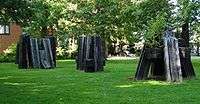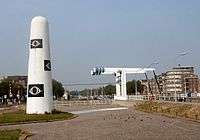Joop Beljon
Johannes Jacobus (Joop) Beljon (January 11, 1922 - December 12, 2002) was a Dutch artist, academy lecturer, director of academy and writer. As artist he was active as sculptor, fiber artist, lithographer, jeweler, environmental artists, and jewelry designer.[1] Under the name J.J. Beljon and the pseudonym Bernard Majorick, Beljon was also writer. Beljon had taken over that pseudonym from the writer Godfried Bomans.
Biography
Beljon was born in Schoten, since 1927 Haarlem. His father was a blacksmith, who had worked at Walden commune of Frederik van Eeden in Bussum. Beljon received his secondary education at the Triniteitslyceum at the Zijlweg in Haarlem.[2] In Haarlem he was a pupil of the sculptor Theo van Reijn, and of the painter, draftsman Floris de Groot.[1]
.jpg)
Beljon settled as independent artist in Haarlem, and later moved to Haarlemmermeer in the 1940s. In 1948 he was listed as one of the foremost Dutch contemporary sculptures in a publication by Theo van Reijn.[3] In 1960 he moved to The Hague, where from 1961 to 1985 he served as director of the Royal Academy of Art, The Hague. Ar the art academy he also lectured environmental design from 1978 to 1980, and design from 1978 to 1980. In 1969 he had moved his art studio to Capelle aan den IJssel, and in 1993 to Oud-Beijerland. He made study trips to Italy and Switzerland.[1]
In 1998 he received the lifetime achievement award for Dutch sculpture, the Wilhelmina-ring, for which he was commissioned a sculpture in the Sprengenstein Park in Apeldoorn (see image). Beljon was married to Gabriëlle Dernison, and died in Oud-Beijerland on December 12, 2002.[1]
Work
Beljon was an environment artist and he worked extensively with architects on projects commissioned by the Government Buildings Agency, among others in The Hague, Arnhem, Apeldoorn, Nijmegen, Groningen and Utrecht.
He carried out work in various countries, such as:
- United States: Homage to Sam Rodia (1965), campus California State University - Long Beach (painted white concrete, 19-piece and 4 to 5 meters high).
- Mexico: Tertulia de los Gigantes (1968) in Mexico City (7 brightly colored concrete towers); sculpture Al Alimon (2001) on the island of Isla Mujeres and sculpture Caballo Negro (posthumous, 2003) in Chetumal, capital of Quintana Roo on the peninsula of Yucatán.
- Bahrain: three gardens, fountains and pool annex (1981) in Bahrain.
- Israel: plastic Dukdalf (1984), Shaltielgebouw in Jerusalem (project with other artists such as Sheila Hicks and Alexander Calder).
Gallery
 Monument Rijkswaterstaat in Den Haag
Monument Rijkswaterstaat in Den Haag Acht objecten in Den Haag
Acht objecten in Den Haag- Fonteinplastiek (1992) in Groningen
 Pilaar met de wakende ogen (1993), Vlaardingen
Pilaar met de wakende ogen (1993), Vlaardingen
References
- Joop Beljon; male / Netherlandish ; sculptor, fiber artist, lithographer, jeweler, environmental artists, jewelry designer, academy lecturer, director of academy at rkd.nl, 2015.
- Over Joop beljon at joopbeljon.nl.
- Reyn, T. (Theo). Nederlandse Beeldhouwers van deze tijd, Elsevier Amsterdam-Brussel
External links
| Wikimedia Commons has media related to Joop Beljon. |